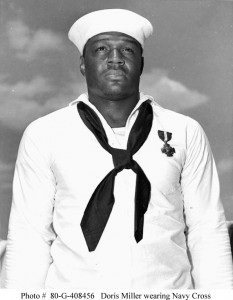Franklin Roosevelt referred to December 7, 1941 as a “date which will live in infamy,” and indeed there’s much about the surprise attack on Pearl Harbor 74 years ago that still inflames our sentiments. But as surely as the years pass, the infamy associated with that date, like that from most battles, attenuates, and the living are left with the duty of commemoration—not of any villainy involved, but of the valor displayed by those who fought.
This crucial transformation of perspective is of the sort Abraham Lincoln crafted in his Gettysburg address, and in similar fashion, today we remember Pearl Harbor through those who there gave the last full measure of devotion.
Of all the heroes from December 7—that is, of all those people whose actions under fire were motivated from a sense of selflessness—none was less likely than a sailor named Doris Miller. His story is inspiring, but, as is necessary in the heroic, it has its deepest root in the commonplace. Miller was a native of Waco who dropped out of high school during the Great Depression and joined the Navy at age 19. He was soon assigned to the battleship West Virginia as a mess attendant. The morning of December 7 Miller was on duty below deck. Within moments after the attack began, seven torpedoes had struck the West Virginia, plunging the ship into chaos. Miller rushed topside to his battle station—an antiaircraft gun amidships—only to find it had already been destroyed.
Miller and the ship’s communications officer then rushed to the bridge to assist the mortally wounded captain. After moving the captain, Miller manned a machine gun (on which he’d not received training) and returned fire against hundreds of Japanese planes. When the attack ended he began the grim work of pulling wounded sailors from the oily water.
In May 1942, Miller received a commendation by the Secretary of the Navy and was awarded the Navy Cross, the first African American so honored. The citation praised his “distinguished devotion to duty, extraordinary courage and disregard for his own personal safety during the attack on the Fleet in Pearl Harbor.”
He found himself something of a celebrity. His image was used in naval recruitment posters throughout the war, and the War Department sent him stateside to give speeches on war bond drives. Eventually he was transferred to duty on an escort carrier and died when it was torpedoed and sunk in 1943. In 1973, the Navy honored him by naming a frigate for him, and in 2010 the post office remembered him with a stamp.
Now an organization called Cultural Arts of Waco in Miller’s hometown is raising funds to build a national memorial to him. The city of Waco donated two beautiful acres downtown along the Brazos River for a memorial site, and a national search was undertaken to select a landscape architect to design the memorial and a sculptor to create the statue that will be at its heart.
Successful artistic commemoration is more sought after than achieved. The selflessness inherent in Miller’s legacy is conveyed not through gigantism (think Sam Houston towering over I-45 in Huntsville) but through intimacy. Nor does it emerge when the individual is abstracted to the point of being a kind of vague Everyman. This in fact is what created such a fuss around plans to build an Eisenhower memorial in Washington, D.C., with even Ike’s grandchildren feeling compelled to weigh in. Architect Frank Gehry’s initial designs somehow managed to make no reference to Eisenhower’s role in WWII nor to the man who later became president of the United States.
A hero is one who embodies the abstract idea of selflessness, so an effective memorial needs to involve both abstract and traditionally representational elements. This is precisely what the planned Miller memorial in Waco will offer its visitors: a statue of Miller at just over life size situating the man himself within an abstract layout that implies his naval service.
Once the memorial is completed it will be one of the most distinctive in the country to any serviceman, and a fitting tribute to Miller and, by extension, all those who served on December 7.


A very good article which has brought my attention to a heretofore unknown hero. I am looking forward to visiting this memorial when it is completed. I remark at how this black man gave his all to save others when blacks were still not treated as equals or anywhere close. This makes this man all the more important to me.